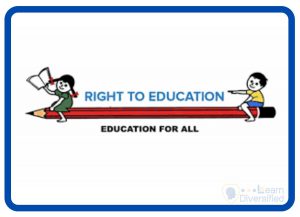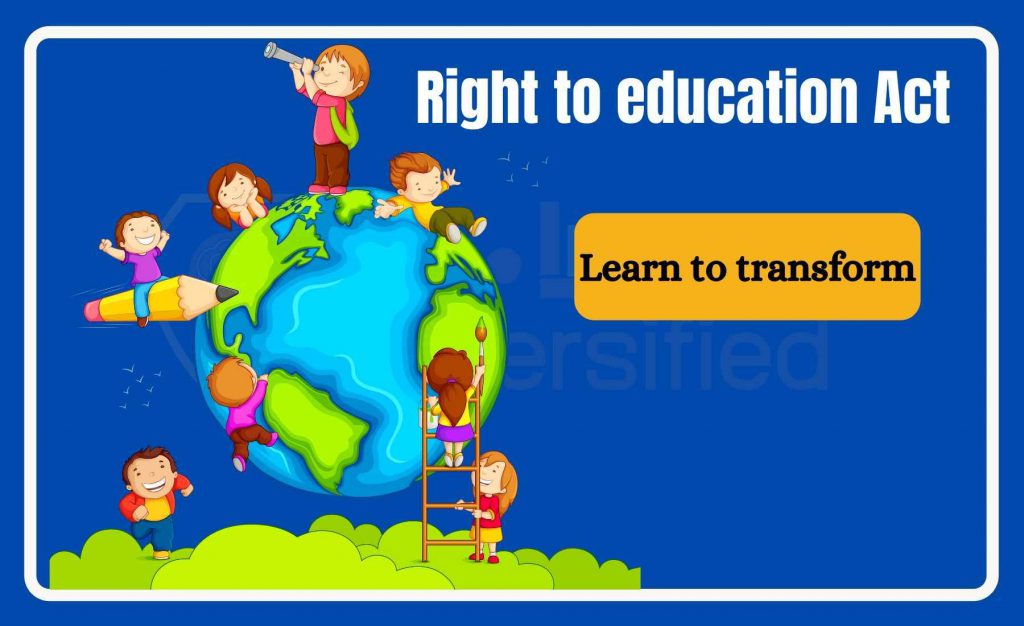
One child, One teacher, One book, and One pen can change the world
-Malala Yousafzai
As the famous quote by the noble prize winner Malala Yousafzai implies, education is the most powerful weapon for a meaningful transformation of the world. The government of India enacted the Right of Children to Free and Compulsory Education Act or Right to Education Act (RTE) on 4 August 2009 to promote the education of the children falling under the age of 6-14. The act offers various benefits to the children especially of the ones belonging to economically weaker sections. Let us explore in detail about the features, benefits, and regulations of the RTE act in this article.
What is RTE act?
According to the 86th Amendment Act (2002), the parliament of India imposed the RTE act under Article 21A of the Indian constitution. The Right to Education Act came into effect on April 1, 2010, and India becomes one among the 135 countries in the world to make education a fundamental right. The RTE act’s title incorporates the words “Free and Compulsory”.
What does “Free and compulsory” mean?
It incorporates the meaning of free and compulsory education offered to the children falling under the age of 6-14. “Free education” refers to any child admitted in the schools need not pay the school fees or any other expenses regarding it, except the children who are admitted by their parents in private schools. Free education is offered by the government in order to provide basic school education to all the children, in which many children drop out of school due to a lack of financial support.
“Compulsory education” means that it is the sole responsibility of the state and local government authorities to ensure the admission, attendance, and completion of the education of the children falling under the age of 6-14 years.
Important elements of RTE act
- All the children falling under the age of 6-14 years possess the right to free and compulsory education.
- The government schools managed by School Management Committees (SMC) will provide education to the children according to this act.
- The act also gave access to private schools to admit at least 25% of children without any fees.
- The function and the quality of the education system are managed by the National Commission for Elementary Education.
Other main features of the RTE act
- Any child is not allowed to pass the board examination or expelled from the school without completing the elementary education.
- Even if a child is above the age of 6 years, he/she is allowed to take up the elementary education. They are admitted to the appropriate classes according to the age and are given special training to cope with their current academics.
- Every child is provided with a certificate after the completion of the elementary education and no fees are required to be paid until the completion.
- The financial burden of the parents to educate the children is taken care of by the central and state governments.
- The act strictly prohibits screening tests, capitation fees, private tuition fees by teachers, and unrecognized schools.
How to avail admissions through RTE act?
The National Commission for Protection of Child Rights (NCPCR) is the concerned authority to manage the provisions of the RTE act. Let us see about the admission process, eligibility criteria, and documents required for the admission.
What schools come under the RTE Act?
All the government and government-supported schools will come under the RTE act offering free and compulsory elementary education. The government also recommends private schools to offer at least free education to 25% of the children. You can avail to any of the recognized neighborhood government or government-supported schools in your area within 1 km radius for free education under this act.
How to apply?
To seek application login to the official RTE website of the specified states you belong to and proceed by filling the details. The website varies for each state and the application procedure may also vary slightly. For example, this is the website to apply if you belong to Tamil Nadu
What is the applicant’s eligibility?
According to the RTE Act, all the children falling under the age of 6-14 years can apply for the elementary education to seek admission in their neighborhood schools. But there is a preference for children falling under disadvantaged sections in which their parent’s annual income should fall below Rs 1 lakh while seeking admissions in private schools under RTE act. This act also provides provisions to special children under “Equal Opportunities, Protection and Full Participation Act”, 1996.
What are the documents required?
The following are some main documents required to apply for admissions under the RTE act.
- Photograph of the student
- Birth certificate
- Aadhar card/ Ration card of the parent or guardian
- Income certificate for economically weaker sections
- Community certificate for disadvantaged categories
The following are the categories referred to as disadvantaged categories and weaker sections by the government
1.Orphan
2. HIV affected/Infected Child
3. Transgender
4. Child with special needs
5. Migrant and street child.
6. Scheduled Caste (SC)
7. Scheduled Tribe (ST)
8. Category-I
9. Category II A
10. Category II B
As the admission process for each and every state varies slightly please check the official website of the state if any additional documents are required.
Eligibility of the teachers
The teachers are recruited based on TET. The persons who pursued or pursuing teacher education courses as per the norms of NCTC are eligible to write TET. The act strictly looks at the mandatory qualified and trained teachers as per the RTE regulations.
Curriculum followed in schools
The curriculum is framed in such a way that the schooling enhances the overall development of a child. To promote this the government also introduced “continuous comprehensive evaluation (CCE)” in 2009 to ensure effective learning outcomes. The curriculum also framed in the view to promote child-friendly schools.
Duty of the parents and community
The RTE act recommends the schools to set up School Management Committees (SMCs). According to this, the schools can set up a committee by including local authorities, parents, guardians, and teachers for efficient functioning through real feedbacks. It is also a mandatory thing to include 50% of women and parents of children from disadvantaged communities. This kind of inclusion will create a holistic community learning.
Infrastructure, Uniforms, and Books
The financial support for the children studying through RTE is taken care of by the state and central governments. The schools should compulsorily maintain pupil-teacher ratio (PTR), which is two teachers for every 60 children. The teachers should continuously monitor students and should take proper care of the learning outcomes. The parents or guardians need not spare the cost of books and uniforms. It is free under the act.
For further more details about this RTE act click https://mhrd.gov.in/rte
Game changer, Changemaker and Dreams fulfiller
Education is the Game changer, Changemaker, and Dream fulfiller of many lives and society. RTE act is one such great way to enlighten many children especially the ones below the poverty line. I hope this article provides you with valuable information to some extent on how to make use of the RTE act. Do read and share this article as much you can.
“Ignorance is the barricade to many great achievements”.
Many young talents may not be aware of this. Let us try our best to ignite the spark in many young talents by sharing this article.
Leave your questions, feedback, and suggestions in the comment box.
For more interesting articles click HOME

